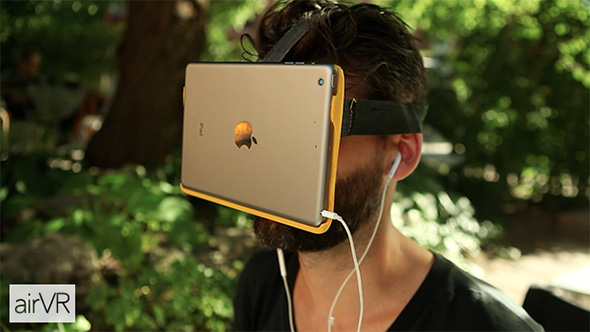Metatecture is hopping on the virtual reality bandwagon with a low-cost alternative called AirVR. Similar to the Samsung Gear VR, AirVR is a bring-your-own-hardware affair, that hardware being an iPhone 6 Plus or an iPad mini. Yes, you're going to look a little (or a lot) ridiculous with an iPad mini pressed against your face, but the upside to this design is cost.
According to AirVR's Kickstarter page, the headset will start shipping in December for just $49. That's much less than the Oculus Rift Development Kit ($300 for DK1 and $350 for DK2) and Samsung Gear VR ($200), and it's probably the reason why over 170 backers have pledged more than CAD$9,600 (~US$8,765) en route to the project's CAD$20,000 (US$~18,260) goal with 28 days left to go.

AirVR is a wireless headset that lets your iOS device do most of the heavy lifting. You simply slide your iPhone 6 Plus or iPad mini into the cradle and then place the contraption on your head. Ergonomic foam pads on the headset portion ensure a bit of comfort, and adjustable ballistic nylon straps makes sure there's a snug fit so your pricey Apple hardware doesn't go tumbling to the ground as you whip your head around to and fro.
Inside the headset are two aspherical lenses positioned above screen to display graphics generated in real time. By tapping into your iOS device's front-facing camera, AirVR can track your head movement without the need for an external camera or additional hardware. And by using the rear-facing camera, you can see what's in front of you. Of course, you can achieve the same effect by just taking the headset off, but if AirVR becomes popular, it will be interesting to see if developers take advantage of this function through augmented reality.
If AirVR is fully funded, you'll be able to place an online order sometime next year.
According to AirVR's Kickstarter page, the headset will start shipping in December for just $49. That's much less than the Oculus Rift Development Kit ($300 for DK1 and $350 for DK2) and Samsung Gear VR ($200), and it's probably the reason why over 170 backers have pledged more than CAD$9,600 (~US$8,765) en route to the project's CAD$20,000 (US$~18,260) goal with 28 days left to go.

AirVR is a wireless headset that lets your iOS device do most of the heavy lifting. You simply slide your iPhone 6 Plus or iPad mini into the cradle and then place the contraption on your head. Ergonomic foam pads on the headset portion ensure a bit of comfort, and adjustable ballistic nylon straps makes sure there's a snug fit so your pricey Apple hardware doesn't go tumbling to the ground as you whip your head around to and fro.
Inside the headset are two aspherical lenses positioned above screen to display graphics generated in real time. By tapping into your iOS device's front-facing camera, AirVR can track your head movement without the need for an external camera or additional hardware. And by using the rear-facing camera, you can see what's in front of you. Of course, you can achieve the same effect by just taking the headset off, but if AirVR becomes popular, it will be interesting to see if developers take advantage of this function through augmented reality.
If AirVR is fully funded, you'll be able to place an online order sometime next year.
No comments:
Post a Comment